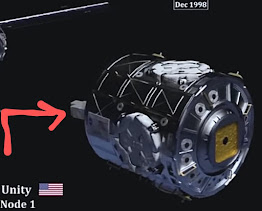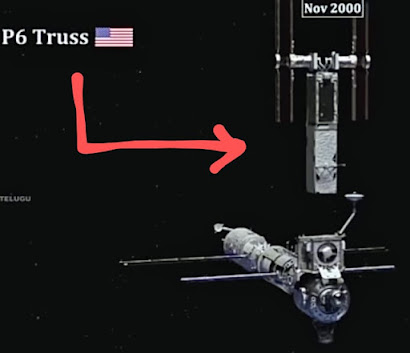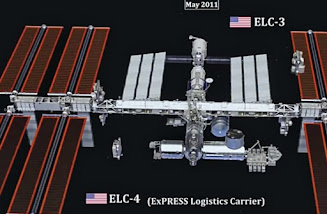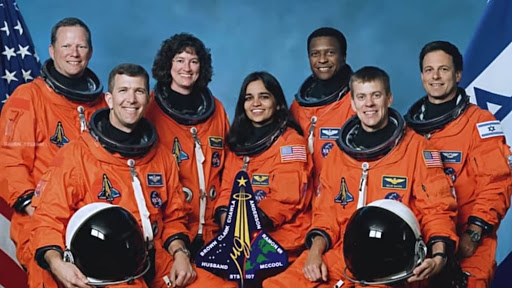- Get link
- X
- Other Apps
hello all,
today I want to explain about the international space station. study carefully.
the International Space Station
specifications of the International Space Station;
the length of Space Station is about 108 meters.
The height of Space Station is about 20 meters.
The width of Space Station is about 74 meters.
The weight of Space Station is approximately 420 tons.
For the construction of Space Station, approximately 110 billion US dollars spent.
The speed of International Space Station is 27700 kilometre per hour.
Human-made heavy weighted Space Station in the space.
It is too tough to make the station and transferred to space from the Earth due to its weight and some other issues.
The whole Space Station assembly work did on the spaces only. the Rockets are allowed to transport the Assembly parts to space, where the Assembly is done by the computerized control.
- Note this seems to be good why because we can see the International Space Station without any Binocular items from the Earth due to its large size.
- The International Space Station is used for the researchers in the space ( Astrobiology, astronomy, space weather and other researchers)
- and also this Space Station is used for a fueling Center for the spacecrafts.
- in the year of 1984, NASA announces this Space Station freedom on low Earth orbit. Due to some technical and political issues the project was postponed.
- In the year 1993 starts the work to complete the whole structure by more countries showing interest in it.
- Due to the many partnerships In Space Station the name Space Station freedom changes to International Space Station.
- Main role possessed by NASA(United States of America) and ROSCOSMOS(Russia) in the space station.
- The Assembly of International Space Station starts and completed between 1998 to 2011.
- Still, the many minor parts are assembling after the last module is fixed to the station in 2011.
- The main concept in the International Space Station is Docking. Docking is nothing but a joint of two components.
- The whole system was built by connecting of several components by using the Docking method.
- The Docking system is not only used for the Space Station but also used for the other spacecraft to dock each other with Space Station.
Note this point: every low Earth orbit space crafts are consists of the Docking system. through this Docking port the astronauts and cosmonauts and to Space Station from the space crafts.
Okay, guys
coming to the main part of the Space Station are components that are used for the construction of it.
- Integrated truss structure act as a backbone for the Space Station. it holds the component of the International Space Station and it is a combination of several Trusses.
- Pressure module, here the astronauts and cosmonauts are can live here without a spacesuit. And also the model consists of some experimental rooms. It consists of 2 orbital segments one build by Russia and the other one is built by the USA.
- Some of the components are utilized for the mechanism and some of other components are used for the experimental purpose In The Space Station.
- Maximum all of the modulus and components of the International Space Station are launched by the United States (Space Shuttle) and Russian( proton and Soyuz rockets).
- All these components are connected in the space and operated and controlled by the laboratory from the Earth.
Guys now the components are starts:
- the first component of the International Space Station is introduced to space by the Russian Proton Rocket in November 1998. The component name is ZARYA functional cargo. It consists of solar rays for the electrical energy storing and also equipped with a propulsion unit, 3 Docking ports on its front, 1 Docking port on its back.
- The second component is from America called NODE 1. In the year of December 1998 equipped with 6 Docking ports. These ports are used for connecting the future components which space companies sent.
- The third component is allowed to inset to the Space Station from the Russian space agency called ZVEZADA. Launched in the month of July 2000. It consists of three Docking ports on its front and a single Docking port on its back it is a Center to Russian orbital segment.
- Z1 TRUSS launched by America in October 2000. It is a part in the integrated structure.
- P6 TRUSS launched by America in the month of November 2000. Which is is fixed to the Z1 truss. Hold by temporary. It consists of solar array wings used for storing the electrical energy in the Space Station and also equipped with radiator panels for the reduction of heat In The Space Station. At this stage of Space Station, the astronauts and cosmonauts are able to visit the International Space Station.
- The next component from America in the month of February 2001 launcher the destiny scientific module. Which is used for many scientific researches can do from here.
- The Other component from Canada is called Canada Arm 2. It is a Space Station remote manipulation system. The launch did in the month of April 2001. It is a robotic arm, it observes what going out of the station. It is operated by the astronauts present in the Space Station.
- In the month of July 2001, the American launched the quest joint airlock. With the help of this component, the astronauts can come out from the station for minor repairs of the Space Station. The come out process is called spacewalk.
- Another component from Russia in the month of September 2001 called PIRS Docking compartment 1 or DC-1. This component is used for the spacewalk and connects the spacecraft which came from the Earth with the help of a special Docking port. Note: after the installation of this component a new and fixed structure is made. After the International Space Station got a good structure and a reliable design from the year of 2002. That station is constructed by using the base as the integrated Truss structure.
- In the month of April 2002, the S zero truss module is connected to the destiny module.
- The next component from Canada in the month of June 2002 called mobile remote servicer base system MBS. This system connected to the S zero truss. It can move and adjust to the Truss. The already connected robotic arm is replaced with MBS.
- The S1 truss (starboard side) and P1 truss (port) from America are connected to both the ends of S zero truss. both the trusses are consist of radiator panels. This is launched in the month of November 2002.
- The month of September 2006 P3 and P4 TRUSSES are connected to P1 TRUSS. It is equipped with solar panels and radiator panels. P5 truss is connected to the P4 truss.it possesses a balancing role to the space station. S3 and S4 truss are connected to the S1 truss in the month of August 2007. S5 truss is connected to the S4 in the month of August 2007. it acts as a balancer to the S series trusses. P6 truss is connected to the P5 truss.
- The next component is sent by America called HORMONY NODE-2.launched in the month of October. It consists of 6 Docking ports connected to the destiny module.
- European laboratory was launched the Columbus module in the month of February 2008 connected to the destiny module.
- In the month of March 2008 Canada component called Dextre connected to Canada Arm 2.
- Japanese experiment module called Kibo. Launched in the month of May 2008 is also connected to the destiny module. It consists of a separate Robotic arm.
- S6 truss connected to S5 truss.now the International Space Station came into the reliable structure.
- In the month of July 2009, launched Japanese exposed facility connected to Japanese module.
- A month of November 2009 from the America the ELC-one Express logistics carrier connected to the station. It is used to stores the hardware and possesses the main role of the proper working of the station.
- ELC-2 component is connected to the upon of the truss in the month of November 2009.
- NODE-3 TRANQUILITY from America in the month of February 2010 connected to node 1 component. It is equipped with a small room called the CUPOLA. It consists of Windows.
- RASSVET from Russia in the month of May 2010 was launched. Mini research module. The purpose of it is material storing.
- Leonardo module February 2011 it is a permanent module with multiple. Launched by America. Connected to Node 3. Stores the materials and wastages.
- ELC-3 AND ELC-4 use for science experiments. Launched by America in the month of May 2011.
- Last component BEAM module. Launched in the month of April 2016. Bigelow expandable activity module.
Note this point important;
for the construction purpose of the International Space Station, almost 116 rockets are used to transport the components.
- The year of 2003, 7 astronauts are caused by death due to the space shuttle blast in the atmosphere.




















Nice expl
ReplyDelete